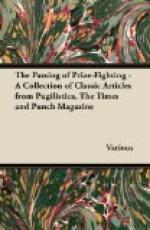* * * * *
THE POLITICAL EUCLID.—NO. 2.
PROP. I.—PROBLEM.
To describe an Independent
Member upon a given indefinite line of
politics.
[Illustration: L]Let C R, or Conservative Reform, be the given indefinite line—it is required to describe on C R an independent member.
[Illustration]
With the centre Reform, and at the distance of Conservatism, describe G B and M—or Graham, Brougham, and Melbourne—the extremes of the Whig Administration of 1834.
With the centre Conservatism, and at the distance of Reform, describe G B and P—or Graham, Buckingham, and Peel—the extremes of the Tory Administration of 1841.
From the point Graham, where the administrations cut one another, draw the lines Graham and Reform, and Graham and Conservatism.
Then Graham and Conservative Reform is an independent member.
For because Reform was the centre of the Whig Administration, Graham, Brougham, and Melbourne
Therefore Graham and Reform was the same as Reform with a shade Conservatism.
And because Conservatism is the centre of the Tory Administration, Graham, Buckingham, and Peel
Therefore Graham and Conservatism is the same as Conservatism with a shade Reform
Therefore Graham and Conservatism is the same as Graham and Reform
Therefore Graham is either a Conservative or a Reformer, as the case may require.
And therefore he is a Conservative Reformer—
Wherefore, having three sides, which are all the same to him—viz. Reform, Conservatism, and himself—he is an independent member, and has been described as a Conservative Reformer.
Quod erat double-face-iendum.
PROP. II.—PROBLEM.
From a given point to draw out a Radical Member to a given length.
Let A or his ancestors be the given point, and an A s s the given length; it is required to draw out upon the point of his ancestors a Radical member equal to an A s s.
[Illustration]
Connect the A s s with A, his ancestors.
On the A s s and A his ancestors, describe an independent
member S R I,
Sir Robert Inglis.
Then with S R I, Sir Robert Inglis, draw out the A s s to G L and S A, or great literary and scientific attainments.
And with S R I, Sir Robert Inglis, let R Roebuck,
be got into a line upon
A, his ancestors.
With the A s s in the middle, describe the circulation of T N, or “Times” newspaper.
And with SRI, Sir Robert Inglis, as the centre, describe
the Circle of the
H of C, or House of Commons.
Then R A, or Roebuck on his ancestors, equals an A s s.
For because the A s s was in the middle of T N, or “Times” newspaper.




